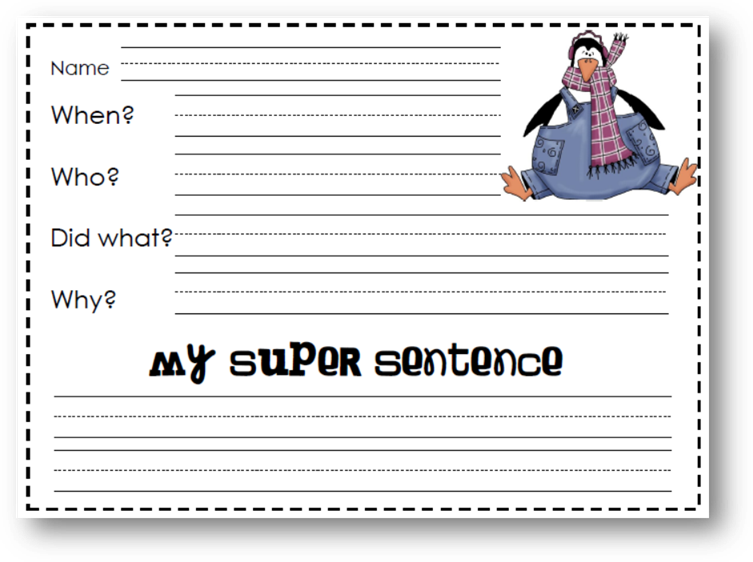Unit Overview
|
Message to Adult
Mentor |
|
This lesson continues a
format that is integrated and includes the reading process (literary and
informational), writing, spelling and fluency. You will be asked to read
aloud and model book handling, left-right reading, expression and fluency.
During Guided Oral Reading, the student will read the story orally and work
on reading strategies and respond to literature. Spelling words will be
introduced during this lesson and a variety of spelling activities will be
assigned. There will be opportunities to make words with magnetic letters and
learn word families. Writing instruction will continue with a focus on
writing sentences and questions. Since daily writing is key to the
reading-writing process, time should be set aside daily for a journal
entry. Topics for writing in the
journal should be self-selected and drawing a picture to accompany the writing
is encouraged. The writing journal will be turned in at the end of the
course. |
Word Power
Sight Word
Scrabble
Fluency
|
Message to Adult Mentor: |
|
Let’s continue to increase sight word vocabulary. These
sentences include common words that appear often in text, which children need
to know instantly for their reading.
In the following sentences, the focus is on the words, which are high
frequency words (sight words). If you notice that the student is having
difficulty with these words, please practice them throughout the week.
|
Read the sentences silently, then aloud to your adult
mentor. It is important to be able to
recognize high frequency words and reading them should become automatic.
1. My shoes are too small.
2. School will start soon.
3. I have ten fingers.
4. We have gym class today.
5. Let’s play together.
6. Please try to be quiet.
7. The soup is warm.
8. They have been around here before.
9. Sam and Jane both want to buy that slimy long lizard.
10. It is always best to say “please” and “thank you.”
Sight
Word Building Fun
Sight Word - Word Search
 Now answer questions 1-10.
Now answer questions 1-10.
Spelling

|
Message to Adult
Mentor |
||||||||||
|
Please read the following to student: In this lesson,
you will learn to spell words with the /au/ sound spelled with the dipthongs “ou” and “ow”
spelling patterns. With your magnetic
letters, make the following words, saying each word as you make it.
Next, the student may choose one or more activities to practice their spelling words each day from the Spelling Menu below! |
Unit 30 Spelling Words
|
Unit 30
Spelling Words |
|
|
1.
mouse |
6.
house |
|
2.
cow |
7.
town |
|
3.
sound |
8.
clown |
|
4.
towel |
9.
pout |
|
5.
cloud |
10.
bounce |
Spelling Menu
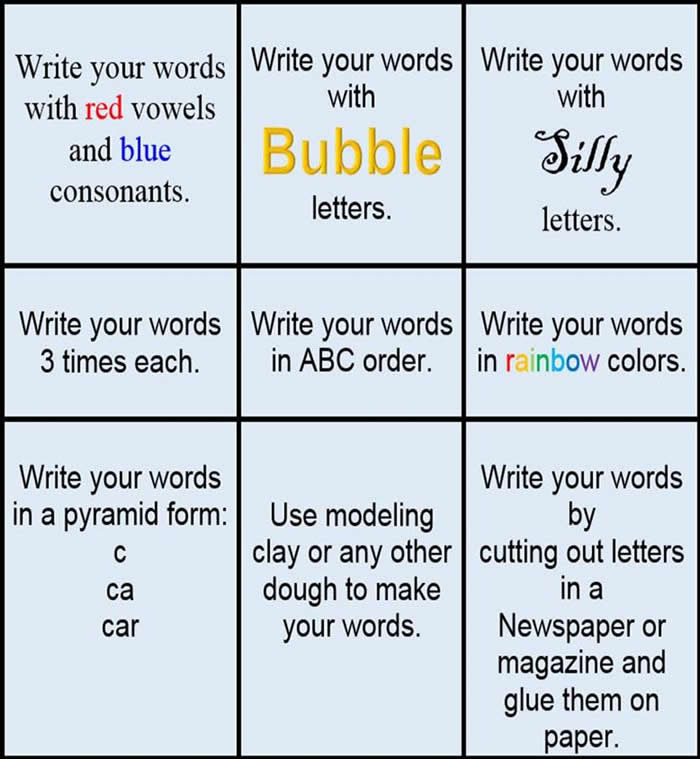
Click on SPELLING TRAINING to practice your spelling words. Add each of your spelling words to the list, then complete one the activites below the list.
Click on the link below to print a
fun activity to help you practice your spelling words!
Word Sort ou and
ow
Highlight a Word- ow and ou

Reading 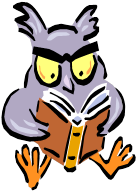
|
Message to Adult Mentor: |
|
Please read this paragraph to the student: It is time to turn
our attention to reading! Throughout
this course you have learned about four types of literary genres; Fiction,
Non-fiction, Fables, and Poetry. In
this unit, you are going to learn about the fifth main literary genre type:
Drama. Discuss the following questions with the
student:
We are going to learn about all the parts of Drama and how to read a
play. |
What is Drama?
Drama, or play, is a story that is
to be performed. The story is told through dialogue, or what the characters say
to one another. A play is acted out
through scenes that show when and where the action is taking place. A drama can be realistic, with characters
acting out a story that could be from real life, either past or present. A drama can also present a fantasy, fable, or
folklore. Drama has some of the same
story elements as fiction- characters, setting, plot, and theme. However, there are many parts of a drama that
make it special and different. Look at
the costumes and scenery in this picture.
What do you imagine this play is about?
Elements of Drama
Plays share several parts in common. The cast of characters is a list of the characters in the play. Dialogue is the words spoken by the characters; in a drama, a character’s name appears before his or her lines of dialogue. Acts and scenes are the parts of a drama; when the setting or time changes, a new scene begins, and sometimes new characters are introduced. A long play might have several scenes grouped into acts. Stage directions are usually found in parenthesis ( ), and tell what a character is thinking, feeling, or doing on stage.
Point of View
The point of view in a drama refers to how a narrator or a character in a story responds to or feels about something. When you read, your point of view might be different from the narrator’s or characters point of view. Dialogue can help you learn about a character’s point of view. How a character speaks and what a character says helps you understand the events of the story as the character experiences them. The narrator’s point of view is that of an observer of the events taking place.
JACK: (excitedly) Mother, you will be so proud of me! I’ve traded our cow for some magic beans!NARRATOR: Jack’s poor mother could not hide her disappointment when Jack opened his hand to show her the three magic beans. |
When reading a drama, you can think about your own point of view and how it relates to the characters and the events taking place. You can ask yourself questions such as “What would I do in that situation?” “How would that make me feel?”
NARRATOR: Long ago, a boy named Jack lived with his mother at the edge of the woods. One day the mother looked in the cupboard and found it empty.MOTHER: Jack, we must sell our brown and white cow. It is the only way to get enough money for food. Please take her to the market now.JACK: Yes, Mother, I’ll do as you ask.NARRATOR: Jack walked to town with the cow and soon met a man on the road.MAN: That’s a fine looking cow! I’d like to buy her. I’ll gladly give you these three magic beans as payment.JACK: (peering thoughtfully at the beans) I bet magic beans would give us all the food we would ever need!MAN: You’re right about that. You’ll never be hungry again.NARRATOR: So Jack traded the cow for the magic beans. |
Pick a character from the scene above. What can you learn about that character’s point of view from the dialogue?
How is your point of view similar to that of Jack? How is it different? What would you have done if you had been offered magic beans for your cow? Discuss your answers with your mentor.
 Now answer questions 11-15.
Now answer questions 11-15.
Close Reading
|
Message
to Adult Mentor |
|
Read the following to
the student: You are now going to do a close reading of the play “A Long Winter.” First, you are going to begin by reading silently to yourself. As you read, it is important that you underline with your pencil or use your highlighter to find important ideas as you read. After you have read the play, talk to your mentor about what you have highlighted. |
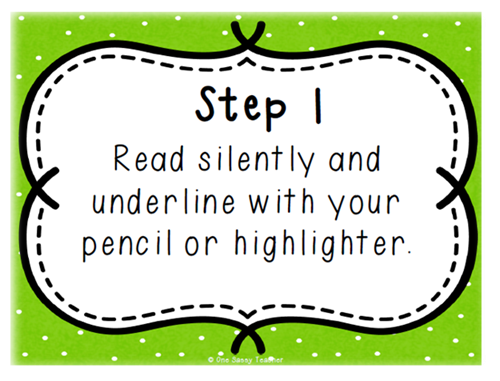
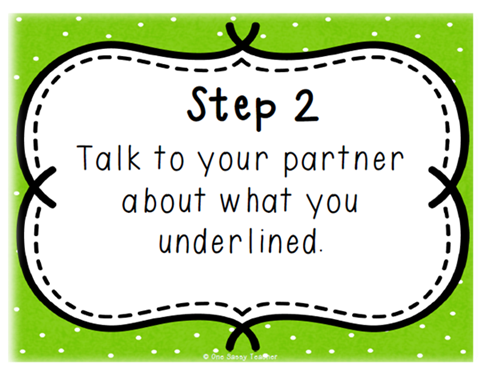
|
Message
to Adult Mentor |
|
Step 3: During the second reading of the story, you are going to read aloud. It is important that you read clearly and model left-right reading, expression and fluency. After reading, discuss the following questions with your student: 1. Who are the main characters in this drama? 2. How long has the sun been gone? 3. What did the animals decide to do at the meeting? 4. What did the animals see inside the tipi? 5. What word means a place where a lot of people live together? |
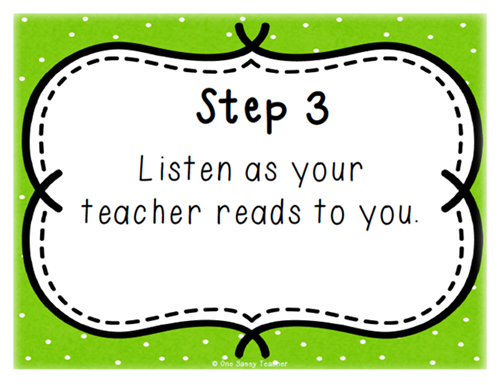
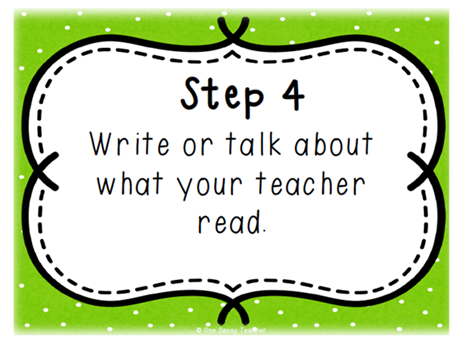
For
the final reading, it is your turn to read aloud! You are going to read “A
Long Winter”aloud to your
mentor. During the reading, it is
important to remember what to do if you come to a word that is tricky for you.
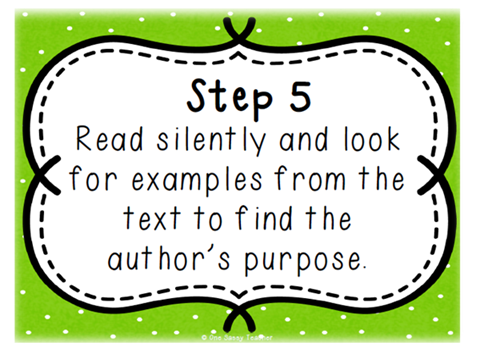
|
Message
to Adult Mentor |
|
As the student reads,
if the student comes to a word that they do not know, lead them through the
decoding strategies. You may also
encourage the student to pause and talk about parts of the story. After the student is finished reading, ask
about the characters in the story and encourage the student to orally retell
what has happened. |
 Now answer questions 16-25.
Now answer questions 16-25.

Writing
about Reading
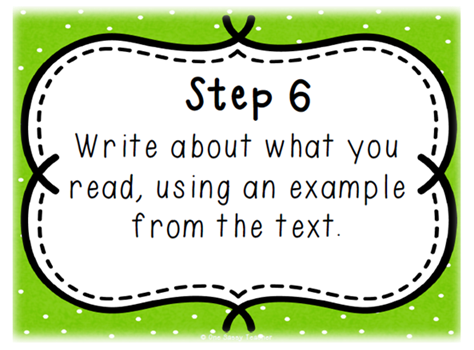
In
your writing journal, describe Mother
Bear, Mouse, and the Little Bears using descriptive
adjectives to write Super Sentences!
If
you forget how to write a Super Sentence, the template above can help you get
started!
Remember,
good writers reread what they write and check to see if it makes sense, if
there are capital letters at the beginning of each sentence and punctuation at
the end of each sentence. One more thing
good writers do is check for spacing between their words. Please reread your paragraph to check for
these important things. Add to your
paragraph or make changes if your need to.
It is also helpful to let someone else, like your mentor, read your
paragraph to check for the same things.
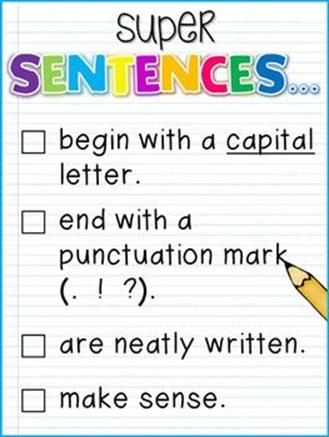
When you are finished, read
the paragraph aloud to your mentor!

Writing- Grammar
Combining
Sentences
|
Message
to Adult Mentor |
|
Read the following to the student and
discuss: We can combine two
or more sentences into a single sentences using a conjunction. Sentences can be combined if they share a
subject, a predicate, or if they are similar.
A conjunction is a word
that is used to connect sentences, phrases, or words. Writers will often use conjunctions to
combine two short sentences into on longer sentence. We are going to be using the conjunctions: for, and, nor, but, or, yet, so. When your new sentence has two complete
sentences, use a comma before the conjunction. Once two complete sentences
are combined using a comma and a conjunction, this is called a compound sentence.
|
We can combine two or more sentences into a single sentences using a conjunction. Sentences can be combined if they share a subject, a predicate, or if they are similar. A conjunction is a word that is used to connect sentences, phrases, or words. Writers will often use conjunctions to combine two short sentences into on longer sentence. We are going to be using the conjunctions: for, and, nor, but, or, yet, so. When your new sentence has two complete sentences, use a comma before the conjunction. The chart below shows a great way to remember the conjunctions, FAN BOYS.
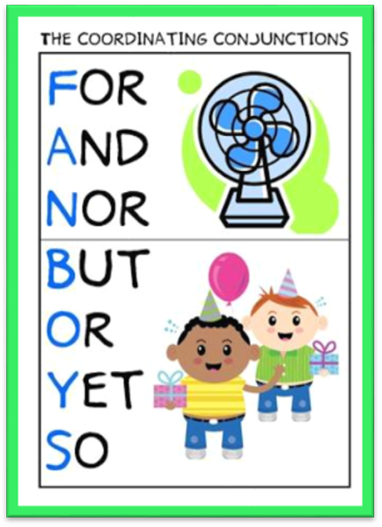
When combining sentences, follow these four easy steps!
1. Read the sentences.
2. Ask yourself: Which conjunction should I combine the sentences with?
a. And? –addition to
b. Or? – choice
c. But? – contrast/ difference/ opposite
3. Combine sentences with a comma and a conjunction.
4. Think: I combined the sentences with _________ because…
Let’s
try a few examples! Read the
sentences. Put the two sentences
together to form a compound sentence.
Discuss your answers with your mentor.
1. I was thirsty. I drank some water.
2. I like ice cream. I don’t like milk.
3. I am leaving at 3:00. I will pick you up at 3:30.
4. He went shopping. He stopped at the bank.
5. I wanted to fly a kite. The wind was not blowing.
Combining Sentences Practice
Combining Sentences
Worksheet
Combining Sentences Task
Cards Game
 Now answer questions 26-35.
Now answer questions 26-35.

Spelling
Test
|
Message to Adult
Mentor |
|||||||||||||||||||||||||||||||||
|
Please feel free
to use the sentences below or create your own! Read the following instruction to student: Now it is time to
take your spelling test. Number your writing paper to ten. Your adult mentor will read the screen and
say each spelling word as you write them. Then, read the sentence provided.
You will send your paper to the VLA Teacher to be checked. Please send it on Friday.
|
|||||||||||||||||||||||||||||||||
Now
it is time to take your spelling test! Number your writing paper to ten. Your adult mentor will read the screen and
say each spelling word as you write them. Then, read the sentence provided. You
will send your paper to the VLA Teacher to be checked. Please send it on Friday.
 Now answer question 36.
Now answer question 36.
Cursive Writing
It’s that time again.
Yes, time to practice writing some new upper case cursive letters. Look below to see what’s in store for you
today.
We will start with the cursive letter
“E.”
Look
carefully at the following animated cursive “E.”
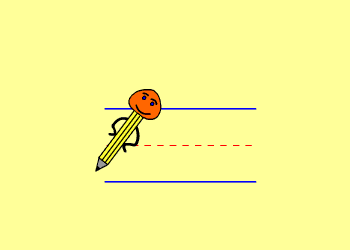
With your mentor’s help, read the chart below. It tells you exactly how to form the cursive “E.”
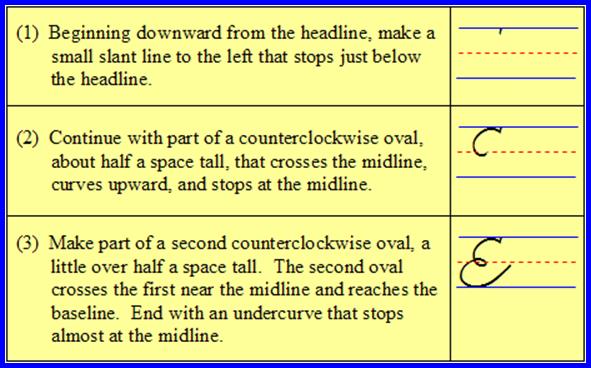
Next, look
at the animated “E” again. As you look at it, trace the strokes in the air. Do this 5 times, or more, if you would like.

Next, practice writing the letter on
paper. Click on this link PDF File to
retrieve and print a worksheet for practice.
You will send this sheet to your VLA Teacher on Friday.
 Now answer questions 37.
Now answer questions 37.
Let’s move on to the cursive letter
“H.”
Look carefully at the following animated cursive “H.”
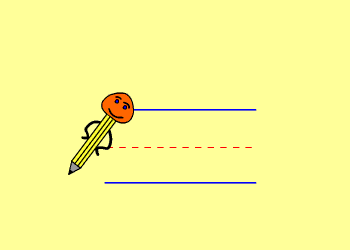
With your mentor’s help, read the chart below. It tells you exactly how to form the cursive “H.”
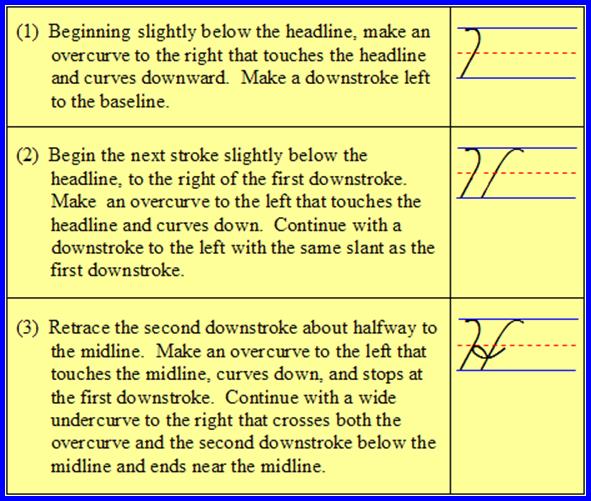
Next, look
at the animated “H” again. As you look at it, trace the strokes in the air. Do this 5 times, or more, if you would like.

Next, practice writing the letter on
paper. Click on this link PDF File to retrieve and print a worksheet for
practice. You will send this sheet to
your VLA Teacher on Friday.
 Now answer questions 38.
Now answer questions 38.
Let’s move on to the cursive letter
“K.”
Look carefully at the following animated cursive “K."
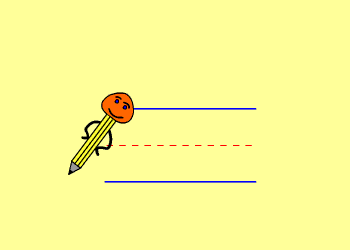
With your mentor’s help, read the chart below. It tells exactly how to form the cursive “K.”
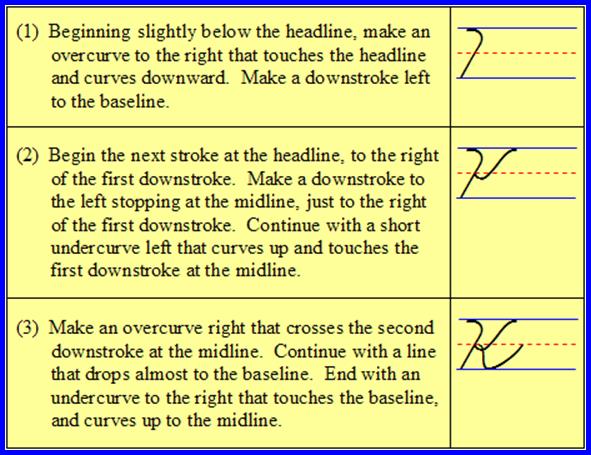
Next, look
at the animated “K” again. As you look at it, trace the strokes in the air. Do this 5 times, or more, if you would like.

Next, practice writing the letter on paper.
Click on this link PDF File to retrieve and print a worksheet
for practice. You will send this sheet
to your VLA Teacher on Friday.
 Now answer questions 39.
Now answer questions 39.
Let’s move on to the cursive letter
“N.”
Look carefully at the following
animated cursive “N.”
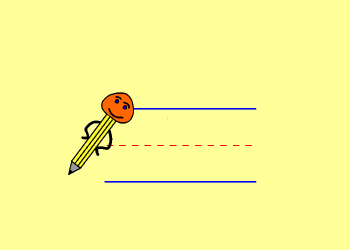
With your mentor’s help, read the chart below. It tells exactly how to form the cursive “N.”
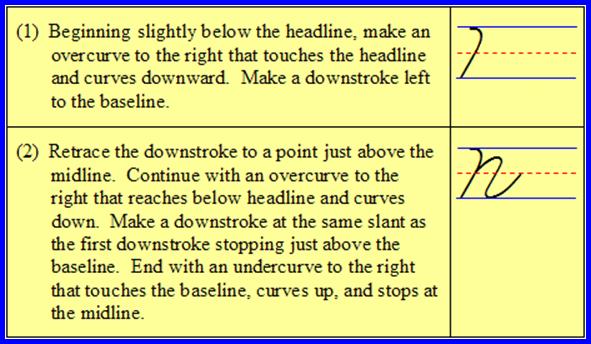
Next, look
at the animated “N” again. As you look at it, trace the strokes in the air. Do this 5 times, or more, if you would like.

Next, practice writing the letter on
paper. Click on this link PDF File to
retrieve and print a worksheet for practice.
You will send this sheet to your VLA Teacher on Friday.
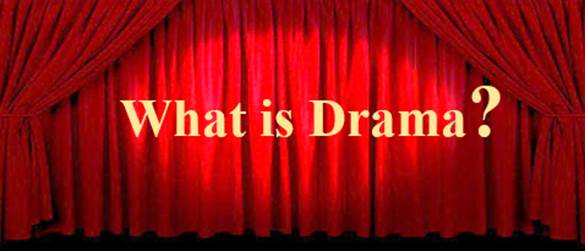
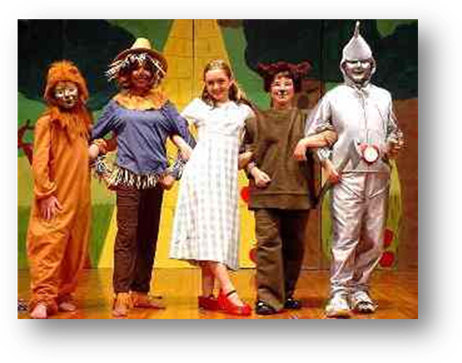
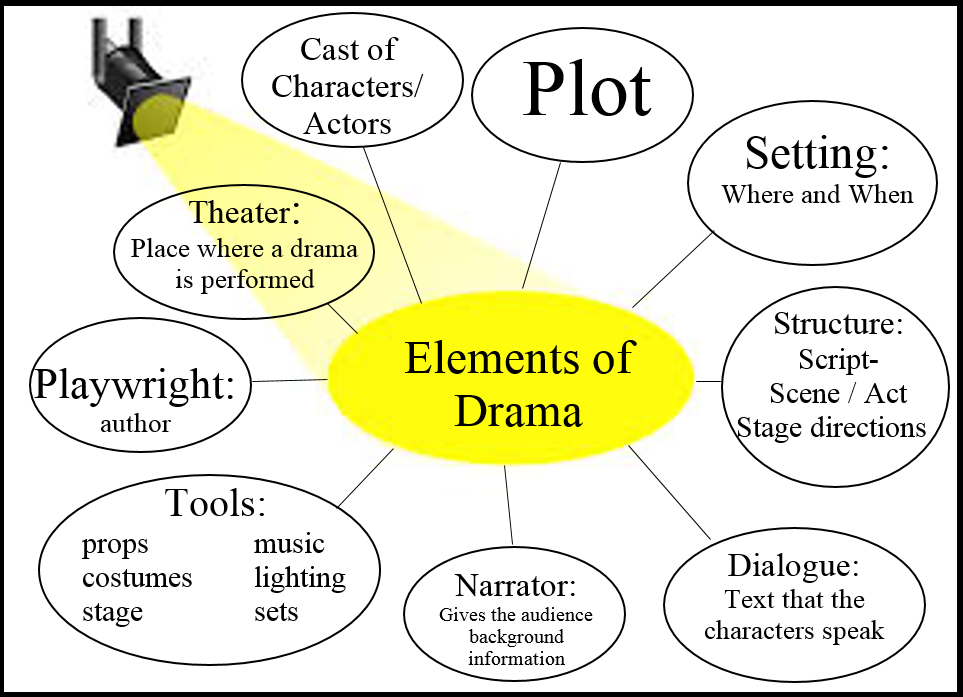
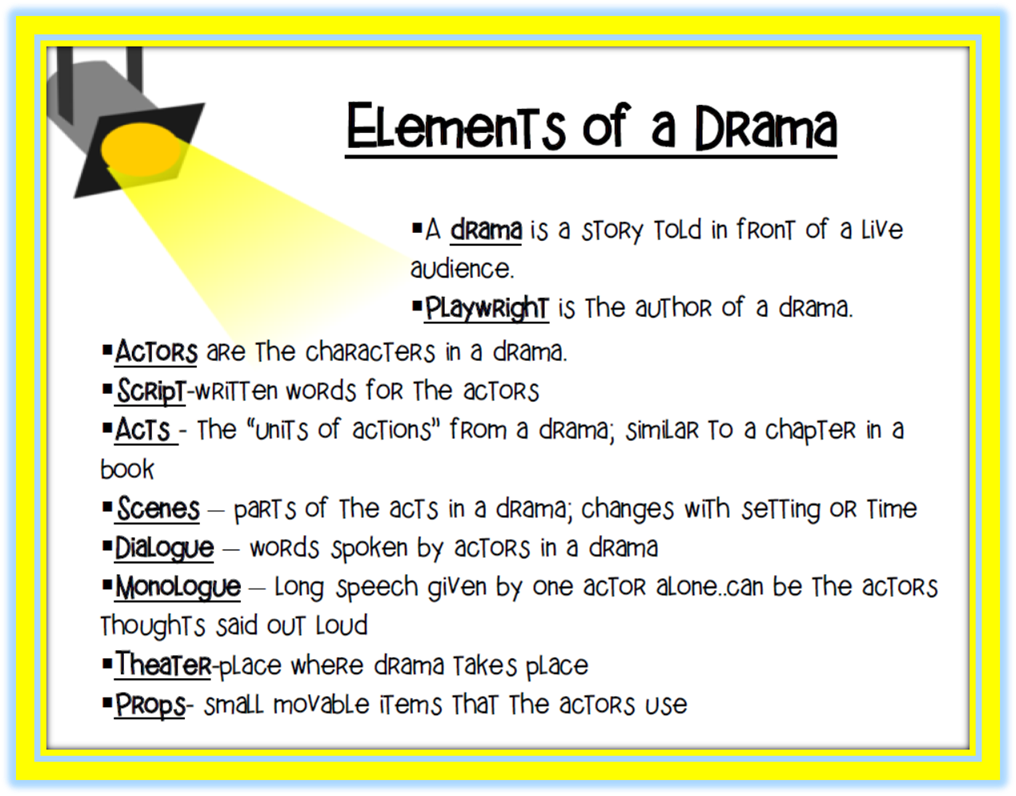
 Print
Print
